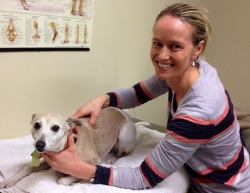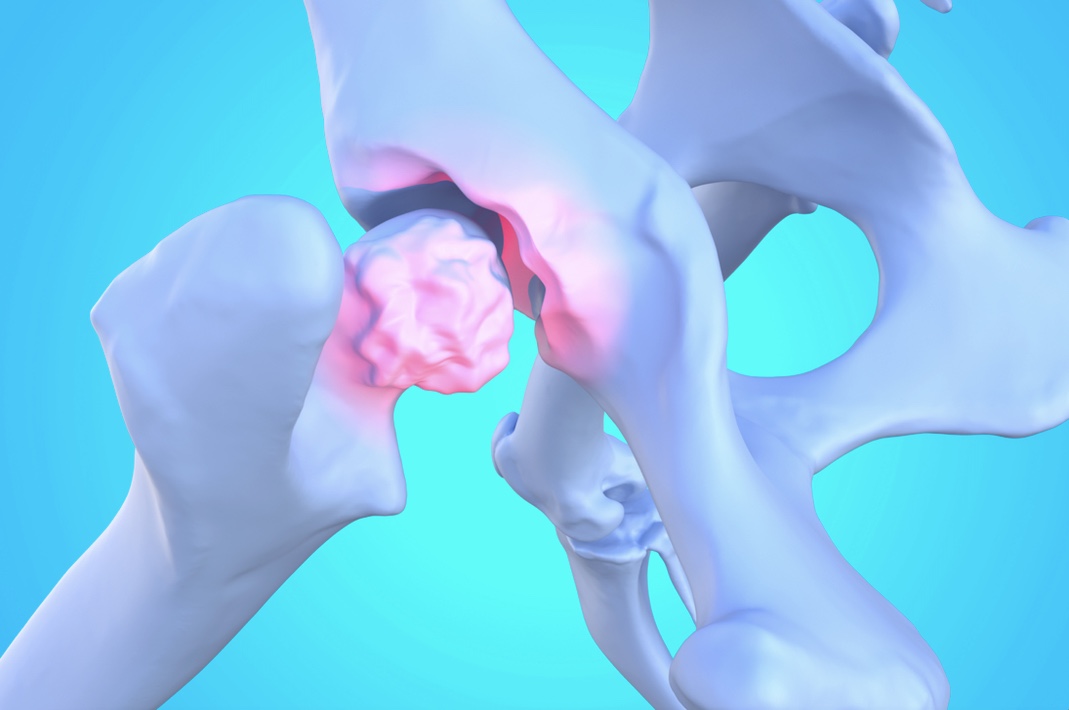Hip dysplasia in Dogs is a disease of the hip in which the ball and socket joint is malformed. This malformation means that the ball portion and its socket don’t properly meet one another, resulting in a joint that rubs and grinds instead of sliding smoothly. This can eventually cause crippling lameness and painful arthritis of the joints. It is a genetic (polygenic) trait that is affected by environmental factors.
Hip dysplasia is one of the most common skeletal diseases seen in dogs. Gender does not seem to be a factor, but some breeds are more likely to have the genetic predisposition for hip dysplasia than other breeds. Large and giant breeds are most commonly affected, including the Great Dane, Saint Bernard, Labrador Retriever, and German Shepherd. Rarely, small breed dogs can also be affected, but are less likely to show clinical signs. Hip dysplasia often begins while a dog is still young and physically immature. Early onset usually develops after four months of age. There are also cases of later onset, where hip dysplasia develops later due to osteoarthritis, a form of joint inflammation (arthritis) that is characterized by chronic deterioration, or degeneration of the joint cartilage.
What is the cause of Hip Dysplasia
In canines, it can be caused by a femur that does not fit correctly into the pelvic socket, or poorly developed muscles in the pelvic area. Large and giant breeds are most susceptible to hip dysplasia (possibly due to the BMI of the individual animal), though, many other breeds can suffer from it.
To reduce pain, the animal will typically reduce its movement of that hip. This may be visible as “bunny hopping”, where both legs move together, or less dynamic movement (running, jumping), or stiffness. Since the hip cannot move fully, the body compensates by adapting its use of the spine, often causing spinal, stifle (a dog’s knee joint), or soft tissue problems to arise.
The causes of hip dysplasia are considered heritable, but new research conclusively suggests that the environment also plays a role. To what degree the causality is genetic and what portion environmental is a topic of current debate. Neutering a dog, especially before the dog has reached an age of full developmental maturity, has been proven to almost double the chance he or she will develop hip dysplasia versus intact dogs or dogs that were neutered after reaching adulthood Other environmental influences include overweight condition, injury at a young age, overexertion on the hip joint at a young age, ligament tear at a young age, repetitive motion on forming joint (i.e. jogging with puppy under the age of 1 year). As current studies progress, greater information may help provide procedures to effectively reduce the occurrence of this condition.
Signs and Symptoms of Hip Dysplasia in Dogs
Symptoms depend on the degree of joint looseness or laxity, the degree of joint inflammation, and the duration of the disease.
- Early disease: signs are related to joint looseness or laxity
- Later disease: signs are related to joint degeneration and osteoarthritis
- Decreased activity
- Difficulty rising
- Reluctance to run, jump, or climb stairs
- Intermittent or persistent hind-limb lameness, often worse after exercise
- “Bunny-hopping,” or swaying gait
- Narrow stance in the hind limbs (back legs unnaturally close together)
- Pain in hip joints
- Joint looseness or laxity – characteristic of early disease; may not be seen in long-term hip dysplasia due to arthritic changes in the hip joint
- Grating detected with joint movement
- Decreased range of motion in the hip joints
- Loss of muscle mass in thigh muscles
- Enlargement of shoulder muscles due to more weight being exerted on front legs as dog tries to avoid weight on its hips, leading to extra work for the shoulder muscles and subsequent enlargement of these muscles
Proper home care and conservative management
If the Hip Dysplasia in your pet is not severe yet, it does not mean that you should not do anything. Early diagnosis allows pet owner to prepare and possibly prevent it from getting worst. Or if surgery is not an option, there are more natural ways to management and live with a dog diagnosed with hip dysplasia.
WEIGHT MANAGEMENT
Weight control is an important aspect of recovery and is recommended to decrease the pressure applied to the painful joint as the dog moves. You and your veterinarian will need to work together to minimize any weight gain associated with reduced exercise during recovery. Special diets designed for rapidly growing large-breed dogs may decrease the severity of hip dysplasia.
MANAGING ARTHRITIS
Arthritis arising from hip dysplasia is commonly known as secondary Osteoarthritis it is important to correct this condition as soon as it is recognized in order to delay the development of degenerative joint disease. If surgical correction is not an option, medical management of degenerative joint disease must include gentle and controlled exercise, weight management, nutritional support and medications to control pain and discomfort.
NUTRITION
It has been found that puppies that reach their final mature body weight a bit later in life do not develop the degree of hip dysplasia found in puppies that are allowed to eat as much as they will. The secret is to keep the puppies growing steadily but to feed them approximately twenty percent less than they would consume when fed free choice.
HOME ENVIRONMENT
There will come a time when it becomes too painful for your pet to climb stairs or go outside to relieve itself. Building a handicap ramp can be helpful and some pets can be paper trained. You will think of other ways you can make life easier for pets with advanced hip dysplasia, that include lowering some of your furniture and placing rubber non-slip mats in your house.
When you take your pet for walks and exercise, try to stay on unpaved grassy areas that cushion his step. Avoid hard-packed pavement and concrete surfaces. This will lessen shock trauma to his hips as he walks or runs. And the worst thing for a dog with hip dysplasia is sleeping on a cold, hard floor. Wood floors and carpets improve matters, but the dog will be most comfortable with an overstuffed dog bed or something similar. Orthopedic foam is also excellent.
PHYSIOTHERAPY
Physical therapy can go a long way in reducing your pet’s pain and debility when dealing with hip dysplasia. Hire a professional or begin by kneading the muscles around the hips with your fingertips in gentle, circular motion. Gradually work your way around the surrounding muscles.
One of the most helpful forms of therapy for your pet is hydrotherapy and underwater treadmills using the beneficial effects of water to minimize the pain and debility of hip dysplasia. This form of treatment is quite effective in reducing swelling and pain.
The importance of Rehabilitation and Physiotherapy for Hip Dysplasia in Dogs
Conservative Management of Hip Dysplasia
Physiotherapy has an important role in the management of hip dysplasia. Whilst hip dysplasia is a progressive disease, the condition can be affected by external factors. The main feature of the disease is joint laxity which leads to changes in the joint, abnormal wear and subsequent osteoarthritis.
Rehabilitation Aims
Initial symptoms that your dog may exhibit can be reduced exercise tolerance, problems going up and down stairs, difficulty rising and lameness after exercise. If your primary care vet or orthopaedic clinician should refer your dog to our rehabilitation service a full physiotherapy assessment is undertaken by one of our chartered physiotherapists. Findings might be – altered gait pattern, with or without lameness, reduced weight-bearing load on the affected limb, weakness of specific muscles (most commonly the gluteal muscles) pain manifested by intolerance to be touched in the affected area or during certain movements or postures and reduced range of movement (ROM). Your dog may exhibit all of or just a few of these clinical signs.
Rehabilitation aims to address the above findings and to maintain and/or prevent progression of the disease. After physiotherapy assessment is completed, a list of focus points is formed and a rehabilitation treatment plan is implemented.
Aims will include the following
- Reduce pain
- Strengthen the affected muscles
- Improve and maintain soft tissue flexibility
- Improve and maintain ROM
- Enhance gait patterning
Rehabilitation Options
Targeted exercises specifically for the gluteal muscles Balance and coordination exercises “Hands on” therapy such as massage and basic stretching for pain relief and improving flexibility Pain relief might be provided using laser therapy and ice.
Hydrotherapy Treatment Options
- Hydrotherapy, particularly underwater treadmill, can be a useful tool for strengthening specific muscles and improving gait patterns. The buoyancy of the water provides support to the body which in turn reduces the load on the affected joints whilst exercising the necessary muscles.
- Any physiotherapy program which is prescribed for your dog is constantly re-evaluated and progressed based on the response to treatment. Owner participation is key as so much of the therapy can be used on a daily basis and provided at home. Detailed instructions are always provided.




2 Comments
vivaro bet casino
Thank you very much for the information provided
Ginger
Our one yr old Golden doodle has been diagnosed with severe hip dysplasia. We will keep is diet , activities with in his limits as we go forward. Thank you you your article it was very helpful in confirming our concerns. We have a pool, so Bailey is getting water therapy.. C hoosing a pain med. Is my next comment for him. We use Merrick dog food and he gets fresh veggies and fruit.